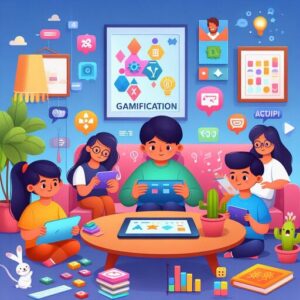In recent years, gamification has emerged as a powerful tool for making learning fun and engaging for children. By integrating game elements into educational experiences, children’s tablet apps can motivate students, reinforce learning, and foster a love for learning. In this article, we will explore the concept of gamification, discuss its benefits for children’s education, and examine effective gamification strategies employed in children’s tablet apps to enhance learning outcomes.

Understanding Gamification
Gamification is the process of applying game design principles and mechanics to non-game contexts, such as education, to motivate participation, enhance engagement, and achieve desired outcomes. In educational settings, gamification leverages elements such as points, badges, levels, rewards, challenges, and leaderboards to make learning more enjoyable and effective. By tapping into intrinsic motivators such as curiosity, mastery, and achievement, gamification encourages active participation, fosters a sense of accomplishment, and promotes deeper learning experiences.
See price for Contixo 10″ Android Kids Tablet 64GB Bundle, Includes 80+ Disney Storybooks & Stickers – Pink https://amzn.to/4a7AtN6
Benefits of Gamification in Education:
Gamification offers numerous benefits for children’s education, including:
-
- Increased Motivation: Gamification taps into children’s natural desire for challenge, achievement, and recognition, motivating them to actively participate in learning activities and strive for mastery.
- Enhanced Engagement: By making learning interactive, immersive, and enjoyable, gamification captures children’s attention and maintains their interest, leading to higher levels of engagement and participation in educational tasks.
- Improved Learning Outcomes: Gamification reinforces learning by providing immediate feedback, encouraging repetition, and promoting mastery through incremental challenges and rewards. Children are more likely to retain information and develop skills when learning is presented in a game-like format.
- Development of 21st Century Skills: Gamification promotes the development of critical thinking, problem-solving, collaboration, and communication skills, which are essential for success in today’s digital world. Children learn to think strategically, adapt to new challenges, and collaborate with peers in virtual environments.
Effective Gamification Strategies
Children’s tablet apps employ various gamification strategies to enhance learning experiences. Some effective gamification strategies include:
-
-
- Progress Tracking: Children can track their progress and monitor their achievements through visual progress bars, achievement badges, and completion meters. Progress tracking provides a sense of accomplishment and encourages children to set and achieve learning goals.
- Personalization: Gamified apps offer personalized learning experiences tailored to each child’s interests, abilities, and learning style. Adaptive technology adjusts the difficulty level of activities, provides targeted feedback, and recommends personalized challenges based on the child’s performance.
- Immediate Feedback: Gamification provides immediate feedback on children’s actions and performance, reinforcing positive behaviors and correcting misconceptions in real-time. Instant feedback helps children understand their strengths and areas for improvement, facilitating continuous learning and growth.
- Levels and Challenges: Children progress through levels, unlock achievements, and overcome challenges as they complete tasks and master skills. Each level presents increasingly difficult challenges and rewards, motivating children to persist and strive for mastery.
- Social Interaction: Gamified apps facilitate social interaction and collaboration among children through multiplayer games, leaderboards, and virtual communities. Children can compete with peers, collaborate on projects, and share achievements, fostering a sense of camaraderie and healthy competition.
- Rewards and Incentives: Gamification offers rewards, incentives, and virtual currencies that children can earn by completing tasks, achieving goals, and demonstrating mastery. Rewards may include virtual goods, bonus levels, special powers, or customizations, providing intrinsic motivation to engage in learning activities.
-
See price for All-new Fire HD 8 Kids Tablet Bundle. Includes Fire HD 8 Kids Tablet |Disney Princess & Made For Amazon PlayTime Volume Limiting Bluetooth Kids Headphones Age (3-7)|Purple https://amzn.to/49btwcJ
Examples of Gamified Learning Apps:
Several children’s tablet apps leverage gamification to make learning fun and engaging. Some examples include:
-
- ABCmouse: ABCmouse offers a comprehensive early learning curriculum for children ages 2-8, featuring interactive games, puzzles, songs, and activities across various subjects. Children earn tickets and virtual rewards as they complete activities, unlock new levels, and progress through the curriculum.
- Duolingo Kids: Duolingo Kids is a language learning app designed for young children to learn languages through play. Children complete mini-games, earn stars, and unlock new characters and levels as they practice vocabulary, pronunciation, and basic language skills.
- Prodigy Math Game: Prodigy Math Game engages children in math practice through an immersive, fantasy-themed adventure. Children solve math problems, battle monsters, and earn rewards to customize their characters and progress through the game’s storyline.
- ScratchJr: ScratchJr is a visual programming app that introduces young children to coding concepts through creative storytelling and animation. Children create interactive stories, games, and animations by snapping together colorful blocks, learning computational thinking skills in a playful and intuitive way.
Best Practices for Implementing Gamification
To effectively implement gamification in children’s tablet apps, consider the following best practices:
-
- Align with Learning Objectives: Ensure that gamification aligns with educational goals and curriculum standards, emphasizing meaningful learning outcomes and skill development.
- Balance Challenge and Support: Provide a balance of challenge and support to meet children at their current skill level and gradually scaffold their learning experiences as they progress.
- Offer Choice and Autonomy: Allow children to make choices, set goals, and customize their learning experiences to promote autonomy, ownership, and intrinsic motivation.
- Provide Clear Instructions: Provide clear instructions, tutorials, and guidance to help children understand how to play the game, complete tasks, and achieve goals effectively.
- Foster Collaboration and Social Interaction: Incorporate opportunities for collaboration, peer feedback, and social interaction to promote teamwork, communication, and community building.
- Monitor Progress and Adjust Strategies: Monitor children’s progress, track performance data, and adjust gamification strategies based on feedback and assessment results to optimize learning outcomes.
In conclusion, gamification is a powerful strategy for making learning fun, engaging, and effective for children. By integrating game elements into educational experiences, children’s tablet apps can motivate students, reinforce learning, and foster a love for learning. Through progress tracking, personalization, immediate feedback, levels and challenges, social interaction, rewards and incentives, and other gamification strategies, children’s tablet apps create immersive learning environments that empower children to succeed academically and develop essential 21st-century skills. As technology continues to evolve, gamification will remain a valuable tool for educators and parents seeking to make learning an enjoyable and rewarding experience for children.

